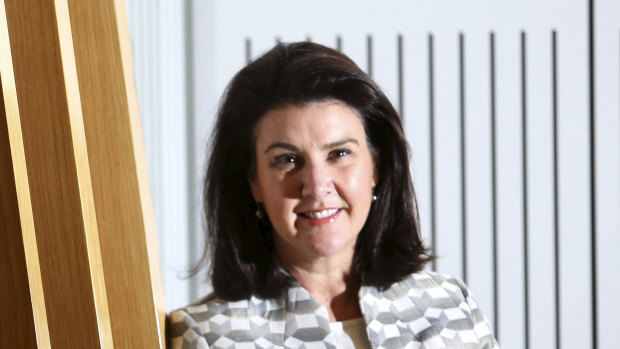Incentives to lure women back to the workforce and boost their earnings and retirement savings will be unveiled by the Morrison government as part of a pandemic recovery plan.
In a sign the government has heeded warnings women are bearing the brunt of the coronavirus-induced slowdown, Assistant Minister for Financial Services Jane Hume will reveal details of a plan to address inequities in the workforce and the gap between women and men's superannuation savings.

Minister for Superannuation and Financial Services Jane Hume will ask the superannuation sector to do more to improve financial education among women.Credit: James Alcock
"I can assure you that the government – and I personally – am acutely aware of the superannuation gap for women," a copy of her speech seen by The Sydney Morning Herald and The Age says. "We know the superannuation system was not designed specifically for women."
A group of female ministers has been working on a new women's economic security statement, in a refresh of a November 2018 report launched by then-minister for women Kelly O'Dwyer. The new version is led by Minister for Women Marise Payne, with input from Senator Hume, Minister for Social Services Anne Ruston, Minister for Employment Michaelia Cash and Minister for Industry, Science and Technology Karen Andrews.
The details are still being finalised, with the federal budget due to be unveiled in October, but Senator Hume's speech to Women in Super's Women's Super Summit says the document forms "an important part in supporting women's workforce participation as we recover from COVID-19".
The 2018 statement included a $109 million women's economic security package over four years, including more parental leave flexibility, scholarships for women in economics and finance, the creation of specialist domestic violence units and a female entrepreneurs' program.
Two major parts of the 2018 plan are still being worked on. This includes information sharing between the Tax Office and the Family Law Courts to help ensure fair splitting of superannuation assets and an early release of super scheme for victims of domestic violence.
Senator Hume will also ask the superannuation sector to do more to improve financial education among women.
"If you are genuine about your desire for gender equity in super – and I believe you are - it is incumbent on the superannuation industry to do more to support the financial literacy of Australian women," she says.
Gender equity was a major focus of several submissions to Treasury's retirement income review, with the Australian Council of Trade Unions suggesting women should be fast-tracked to a 15 per cent superannuation guarantee and banks, state governments and women's advocates recommending super be paid on parental leave. A final report was handed to the federal government last month but has not been publicly released.
"The system designed in 1992 does not account for a number of factors that contribute directly to the superannuation savings gap, namely the gender pay gap, time out of the workforce due to caring responsibilities and the decision of many to work part-time," Senator Hume says.
She will also double down on the superannuation early access scheme, which allows struggling workers to withdraw up to $20,000 from their retirement funds. The scheme has been criticised by industry super funds for being open to fraud and misuse but the Tax Office has not found a high proportion of ineligible applicants.
"It has helped millions through this crisis, it will continue on its path to fund our retirements – and, like all of us – it will weather this storm," she says of the scheme.
Australian Prudential Regulation Authority data released on Tuesday shows superannuation assets at the end of June 2020 totalled $2.9 trillion, down 0.6 per cent over the past 12 months. A total of $37.4 billion of benefits were paid over the quarter, largely reflecting the early release withdrawals during the pandemic. This left quarterly net contribution flows in the red by $2.3 million for the first time since compulsory superannuation began.